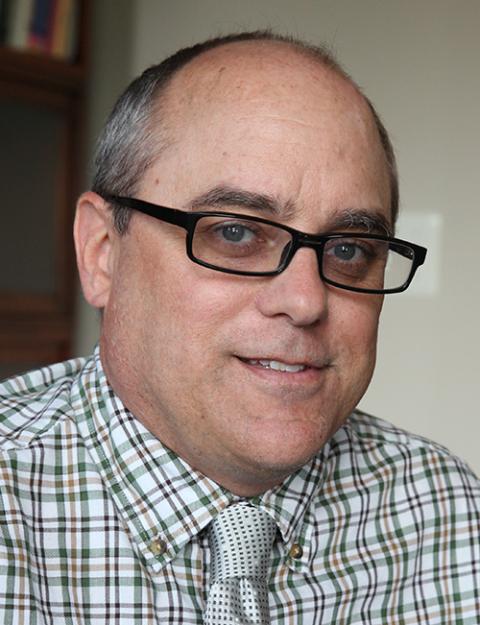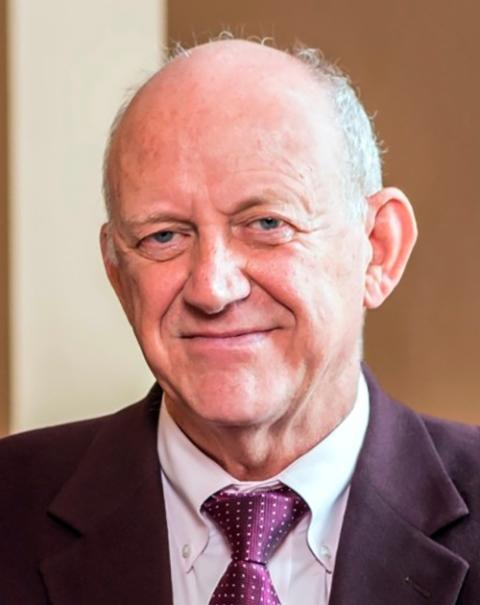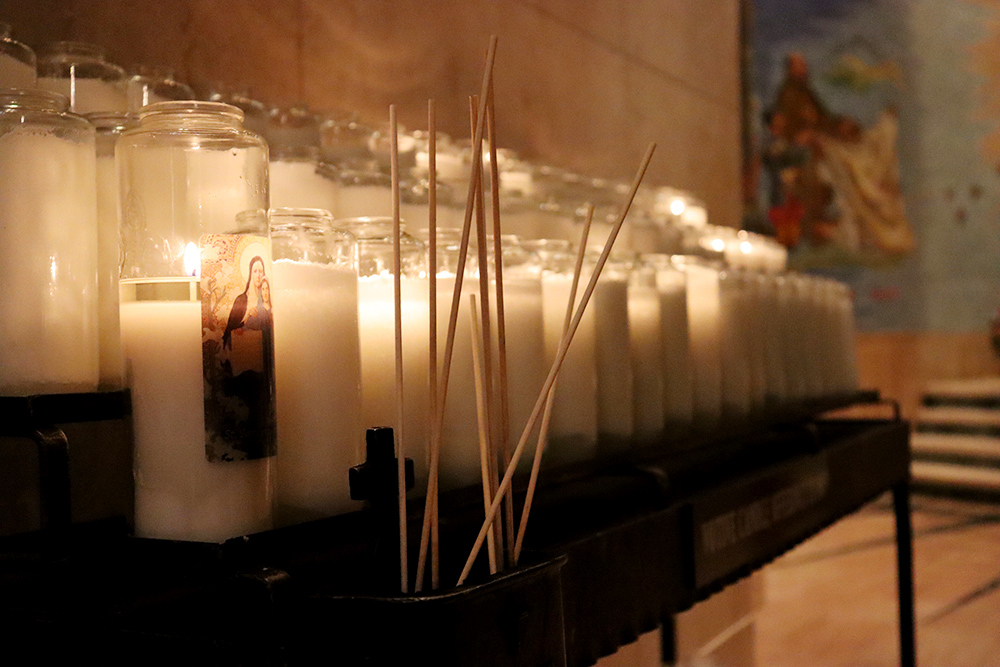
Votive candles are seen in the Basilica of the National Shrine of the Immaculate Conception in Washington, D.C. (NCR photo/Teresa Malcolm)
Editor's note: According to a 2008 Pew Research study, one of 10 U.S. adults is a former Catholic. Some have moved on to other denominations, others have no church affiliation at all, still others have formed their own communities of former Catholics. In this five-part series, former NCR editor Tom Roberts examines the choices many former Catholics have made as they decided to move away from the institutional church. Read Part 1 here.
If "demography is destiny," then a certain narrative is baked into the data describing the Catholic Church in the United States. Change is the primary theme, the constant reality over decades.
In today's parlance, the church is often said to be at "an inflection point." Such points certainly seem ubiquitous during the Francis papacy. Change has been at the core since Pope Francis appeared post-election on the balcony of St. Peter's Basilica having left behind most of the ornaments of the office.
His use of the synodal process seems designed to gather in all of the changes that are altering the landscape of the church and causing, at least in some circumstances, an exodus from usual Catholic practice.
From the global to the local, things are changing. In the United States, this is no longer your mother's or grandmother's church, but one that is increasingly multicultural and non-European, with fewer ordained priests every year. Those are trends that are beyond hierarchical control.
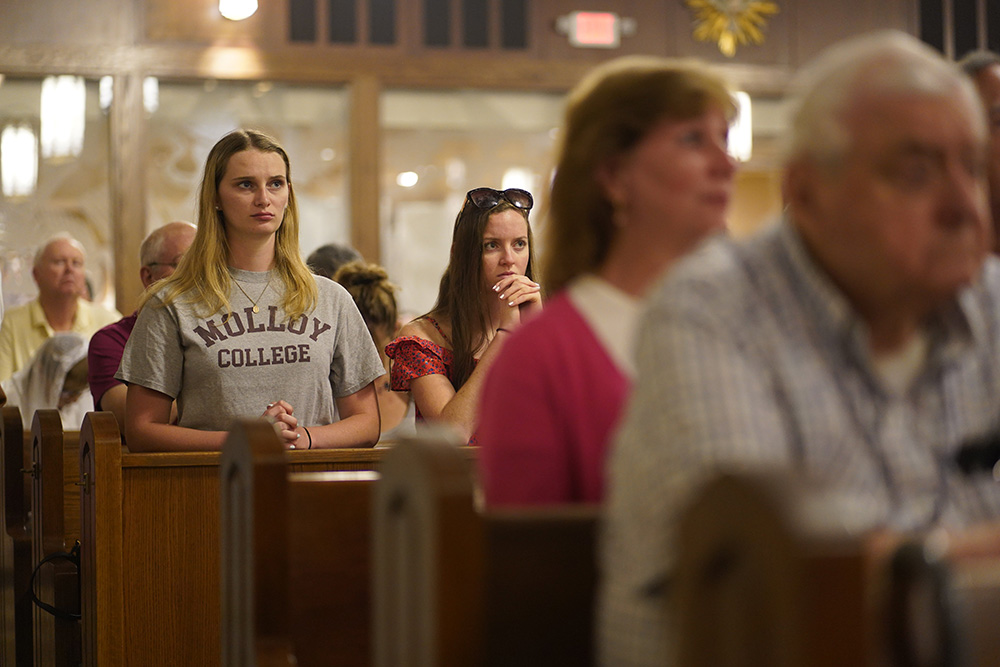
Congregants pray during a special Mass for vocations at Cure of Ars Church in Merrick, New York, Aug. 4, 2022. The liturgy was sponsored by the vocations office of the Diocese of Rockville Centre, New York. (CNS/Gregory A. Shemitz)
Changes in the institutional structure, brought on again by demographic forces beyond the control of any authority figures, are also inevitable: The numbers simply no longer exist to sustain the parochial structures of yesteryear.
Unclear is exactly what form those inevitable changes will take. Ever larger congregations to accommodate decreasing numbers of priests? More responsibility for permanent deacons, another layer of all-male ordained clergy? Greater roles for women, perhaps even as deacons? Maybe something entirely new?
Dramatic jolts to local communities such as closings or new authoritarian pastors, combined with the sustained effects of the sex abuse scandal and cover-up, not to mention the COVID-19 pandemic, all probably have contributed to the growth of the diaspora. However, the exodus began long before those events; it parallels the diminishment of Catholic institutional life in the United States that has been underway for decades and, in some categories, for more than half a century.
Advertisement
The Center for Applied Research in the Apostolate (CARA), affiliated with Georgetown University, has a page on its website of frequently sought statistics on major trends in the Catholic world.
It is largely a tale, in numbers, of ongoing and massive institutional change. It could be viewed, at least in part, as a story of insistent, decadeslong, decline. For instance, what once was referred to as a priest shortage, suggesting it was a temporary supply problem to be remedied by ramped-up recruiting and revved-up vocation offices, has become a permanent reality. But the data show that the numbers just represent a return to what once was normal after an unusual period of vocational growth.
The year 1965 is the first on the CARA chart and the highest point shown for Catholic clergy in the United States, with 59,426 total priests, including diocesan and members of religious orders. In 2022, the number was 34,344. The data, according to CARA, covers dioceses and eparchies in the United States and in the U.S. Virgin Islands.
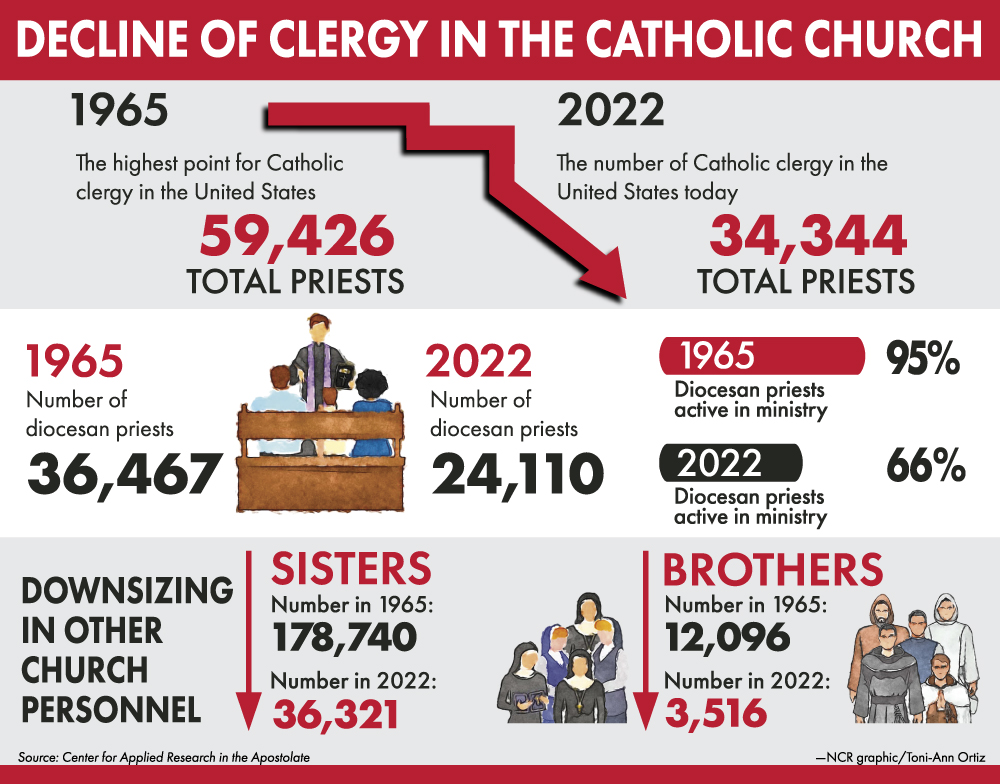
In 1965, the number of diocesan priests, those most likely to be involved in parish work, stood at 36,467. Today, that number is 24,110. In 1965, 95% of diocesan priests were active in ministry. Today, only 66% are active. The others are mostly retired or too ill to serve. Consequently, only 15,912 priests are actively involved in ministry.
Several factors make that last figure significant. The first is that the number of parishes in need of priests, given the laws requiring priests for certain sacraments, totals 16,429. The second is that priests are not evenly spread out across the country, so what appears on paper to be a nearly one-to-one match isn't the case in reality. Third, the priesthood is aging.
Other foundational elements of the institution as we've known it have undergone similar downsizing. The number of religious sisters has plummeted from 178,740 in 1965 to 36,321 last year. Over that same period, the number of religious brothers went from 12,096 to 3,516.
From shortage to normal
Mark Gray, who edits the Nineteen Sixty-four blog for CARA, noted in a 2013 entry that what we in the United States have considered a priest shortage in recent decades is really nothing new. Prior to 1950, the ratio of priests to parishes was similar to the ratio that exists today.
"The late 1950s into the 1970s represent an exceptional period in American history when there were significantly more active diocesan priests available than there were parishes," he writes. "Age and mortality has and continues to diminish the size of the diocesan clergy population. Although ordinations have remained stable for decades, these are not sufficient to make up for the number of priests lost each year to retirement or death."
Nothing of significance has changed to alter those trends in the 10 years since he posted that observation.
That's a quick portrait of the decline of the institutional infrastructure that supported the rigorous presence of Catholics in parochial settings, particularly in the Northeast and Upper Midwest. The image that took hold in popular culture, including Hollywood, and accepted as immutable Catholic reality — convents and rectories stuffed with priests and sisters — was a short-lived phenomenon. The post-World War II spike in men's and women's religious vocations lasted roughly into the late 1960s or early 1970s, when a massive exodus of men and women from ordained and vowed religious life took place.
By all measures, that period of abundance was an anomaly. Such numbers were a one-time occurrence.
For the Catholic priesthood in the United States, the immediate postwar era was a time of "booming enrollments" in U.S. seminaries, writes historian Leslie Woodcock Tentler in her book American Catholics: A History. "American seminaries were filled to bursting in the postwar years, when new seminaries were opened and existing ones being expanded at a rate never previously equaled."
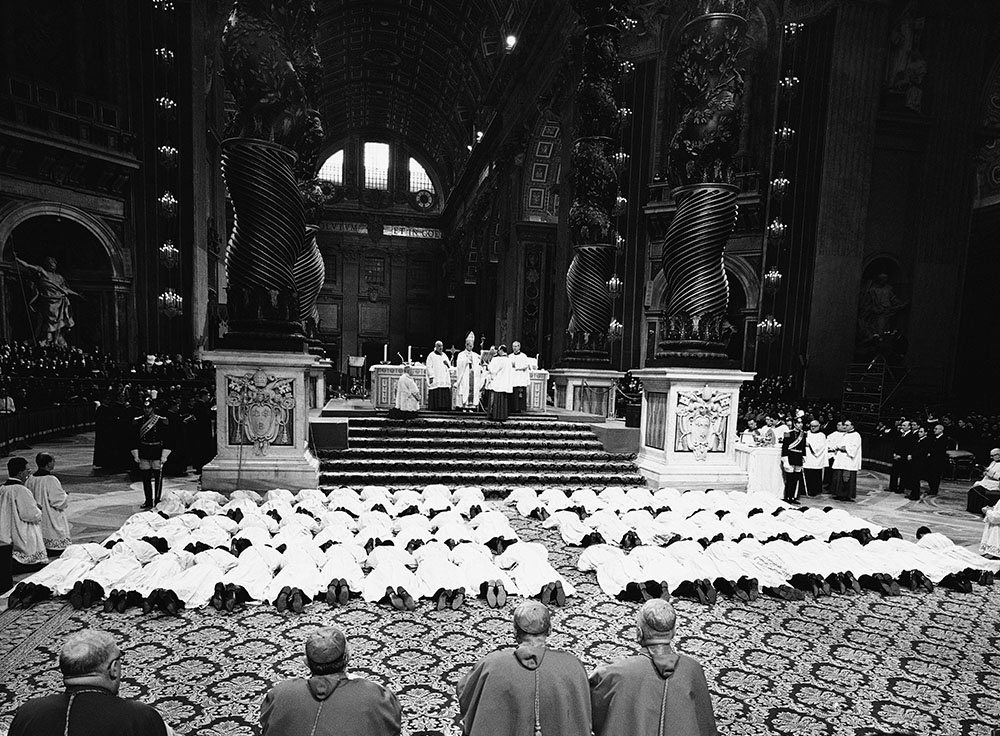
Pope Paul VI ordains 62 seminarians from 23 countries in St. Peter's Basilica, Vatican City, Jan. 6, 1966. It was the first conferring of holy orders by a pope in modern times. (AP/Mario Torrisi)
The men of that era underwent a formation "premised on a high cultic vision of priesthood," according to Tentler. In the wake of the Second Vatican Council, however, the support for that vision crumbled under a combination of forces that raised questions about the essential nature of priesthood. What followed was "an unprecedented wave of resignations from the active priesthood ... and an abrupt decline in seminary enrollments."
Another part of the U.S. Catholic puzzle that comes clear the further we move from that anomalous period is how vital immigration has been in propping up the church's bottom line in terms of membership.
Arguably, the church has always been sustained by waves of immigration. It is unlikely, however, that in the past immigrants were making up for those who were leaving the church, as is the case today when one in 10 in the United States is a former Catholic.
Today, the growth areas of the global church are primarily in Asia, Africa and Latin America. While the raw data would include the church in the United States as an area of growth, defying all of the trends one sees in much of the developed world, a deeper look quickly reveals what might be termed another anomaly.
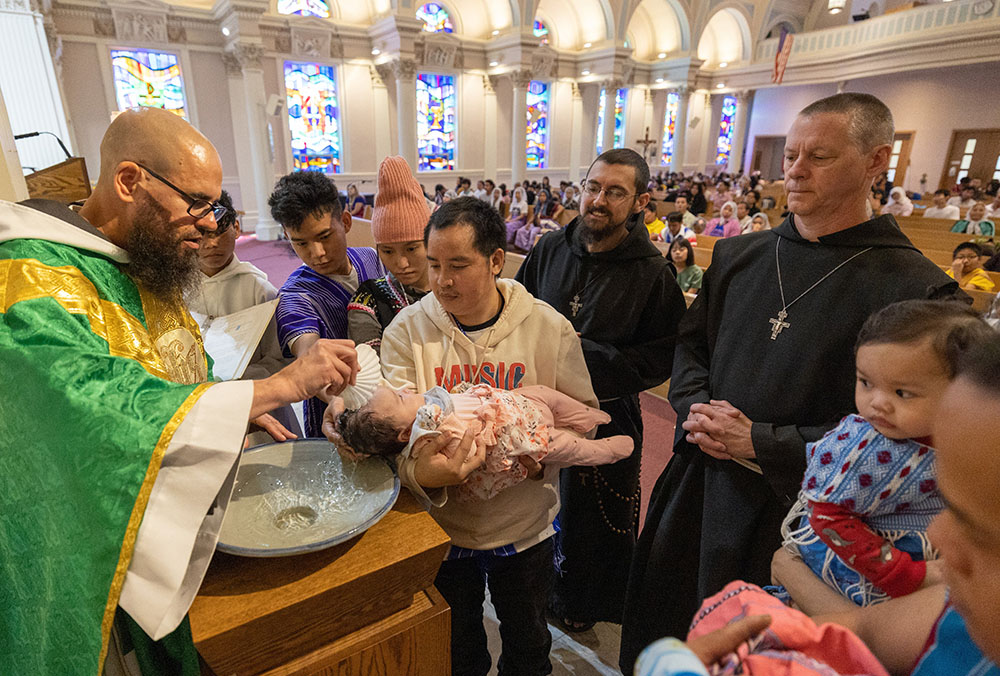
Fr. Seraphim Wirth, a member of the Franciscan Brothers of Peace, baptizes a baby from the Karen community during Mass at St. Casimir Church in St. Paul, Minnesota, Sept. 11, 2022. (CNS/The Catholic Spirit)
According to CARA, the Catholic population in the United States peaked in 2005 at 81.2 million. Since then, it has steadily declined to 73.5 million last year.
During that same period, the number of foreign-born Catholics in the U.S. also peaked in 2005 at 17.6 million. Since then, their numbers dropped to just more than 13 million through 2015 and rose again to 15.6 million in 2020 and 15 million last year. Their numbers help the church maintain a robust bottom line.
If the number of immigrant Catholics are subtracted from the total, the number of Catholics in the United States would stand at 58.5 million, or roughly the same number who self-identified as Catholics in 1985.
Synodality and change
In many aspects, the synodal process appears a kind of gathering-in of difficult questions that have persisted, changing the shape of the church, even though in the past such topics as women in the church, acceptance of LGBTQ Catholics, divorced and remarried Catholics, and married clergy were deemed out of bounds for discussion at the highest levels of church governance.
Francis, however, has opened the discussion in unprecedented ways.
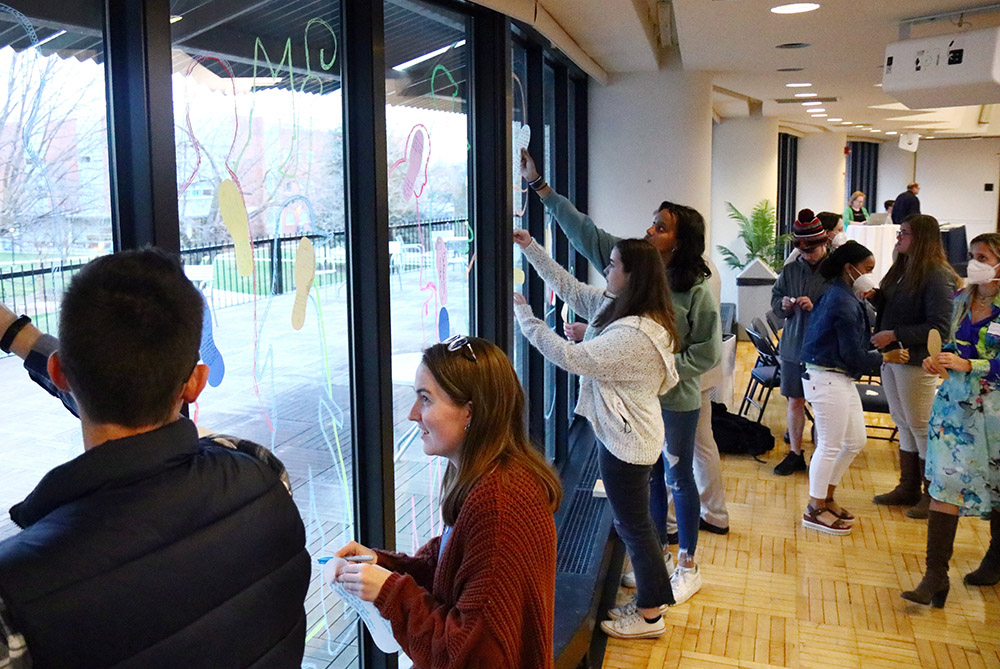
Participants in a synod listening session at La Salle University in Philadelphia write messages about the experience April 4, 2022, and attach them to the windows of a conference room for passersby to read. (CNS/CatholicPhilly.com/Sarah Webb)
Among the points outlined in the instrumentum laboris, or working document, for the synod beginning in October are a questioning of the very nature of authority; a realization that "institutions and structures alone are not enough to make the church synodal"; and a need for new language in the church's "liturgy, preaching, catechesis, sacred art, as well as in all forms of communication."
The document also emphasizes a need for new formation of clergy.
Unknown, of course, is the consequence of all those fundamental questions as the synod discussions play out over two global gatherings this year and next.
But in the United States, at least, demographics will continue to be the uncontrollable element in any future. And many of the measures indicate a continuing decline.
For instance, according to CARA data, infant baptisms reached a high point of 986,306 in 1990. Last year, they were fewer than half that number, 437,942. Likewise, confirmations dropped from a high of 630,465 in 2000 to 497,661 last year. The trend lines of consistent decline are similar for other sacraments and for such things as Mass attendance and regular prayer.
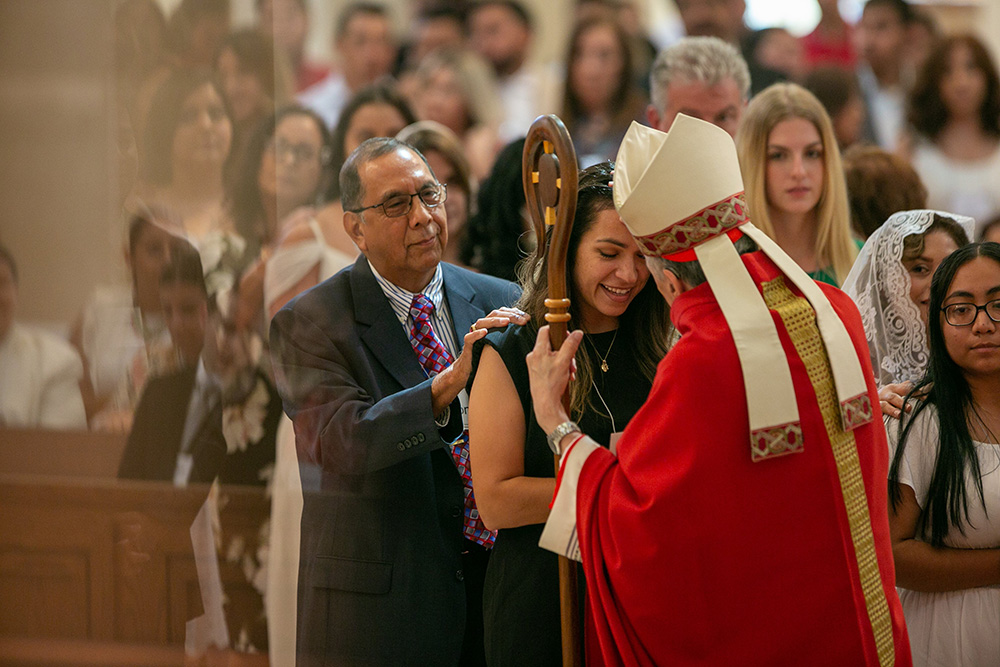
Cardinal Daniel DiNardo of Galveston-Houston anoints the head of a confirmation candidate at the Co-Cathedral of the Sacred Heart in Houston June 5, 2022, during a celebration of the sacrament of confirmation. (CNS/Texas Catholic Herald/James Ramos)
Some of that decline has to do, again, with simple demographics. Explained Gray in an email: "We are living in one of the most extraordinary periods in history where the human population will peak and then fall," he said.
Two primary factors are at play to create a population peak — lower infant and maternal mortality and longer life spans.
"At the same time," he explained, "births began to decline in 2000 when we hit 'peak child' and have continued to dip. Eventually, these two trends will catch up to each other and the global population will decline year over year as it already is in Italy, Japan, etc. ... Our population pyramid will begin to invert and you will have many more people over 65 than under 25."
Catholic by choice
Theologian Thomas Groome, director of the Church in the 21st Century project at Boston College, sees a significantly transformed model of church in the future, one based on choice.
"Nobody's going to be Catholic just because they're scared, or because their mother was Catholic," he said.
Imagining a place for the church in a postmodern world, Groome, referencing sociologist Charles Taylor said, "We've boiled down postmodern society to a clear choice: Either a purely imminent way of living our life — eat drink and be merry for tomorrow we die, but go to an art gallery occasionally or listen to good music to take care of the aesthetic and the spiritual for yourself ... or we have a transcendent perspective, a God view of life, what [theologian Karl] Rahner calls a transcendent horizon."
In the latter case, Groome still sees a place for parish as a focal point for people in various stages of attachment. He asks, "Can we help people who lead a graced life in the world and make a living and have a life but also live their life into this transcendent horizon that Christians believe is God and Jesus, revealed as God of unconditional love for all of us?"
He holds one stipulation as essential to the church of the future — ordination of women and giving women greater authority in the church.
"It's imperative, it's imperative," he said. "We're ridiculous without that. We're dysfunctional without that. And sinful. It's sinful; it's discriminatory. It's a mortal sin, to use good old language of the institution."
In 30 years of teaching undergraduate students, said Groome, author most recently of What Makes Education Catholic: Spiritual Foundations, he has seen young adults relatively unfamiliar with Catholic tradition "come to love it, and they could embrace it with great enthusiasm, they could make a choice for it."
He thinks the church can still make a persuasive argument for that tradition. "I think we still have something to render and something to offer in this postmodern world that nobody else does nearly as well."
Parts 3, 4 and 5, coming soon, will profile three communities that, facing closure or a complete revamping by a bishop or new pastor, decided to stay together but worship in a different space.

